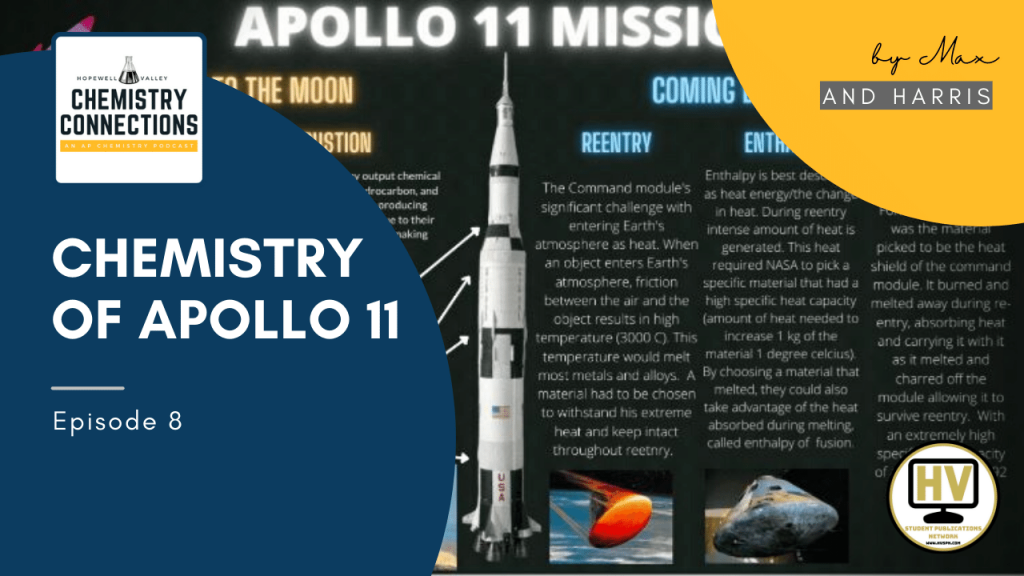Chemistry of Apollo 11

Hopewell Valley Student Podcasting Network
Chemistry Connections
Chemistry of Apollo 11
Episode #8
Welcome to Chemistry Connections, our names are Max Warias and Harris Hamid, and we are your hosts for episode #8 called Chemistry of Apollo 11. Today we will be discussing the chemistry and history of the Apollo 11 Mision/
Segment 1: Introduction to Apollo 11 Mission
- Explain what the Apollo mission was and why the US wanted to go to the moon. Discuss the technological advancements at the time and the space race with Russia.
- Discuss why it was such a big deal and how big of a success it was.
- Under a decade between Kennedy’s speech and the moon landing
- Massive importance in tandem with Cold War
- There were two main parts to the mission. Getting to get to the moon and getting back home
- Leaving Earth: Talk about the Saturn V rocket. rocket propulsion, nose cone with pressure matching with exit gas velocity. Cone volume manipulation. Talking about efficiency
- Getting down: Talk about the command module. How it had to disperse heat from reentry going thousands mph. All the drag creates heat which needs a proper heat shield.
Segment 2: The Chemistry Behind rocket propulsion
Leaving Earth’s Atmosphere
- Chemistry of propulsion
- Combustion reactions
- Fuel consists of a primary fuel, generally a hydrocarbon, and an oxidizing agent, either oxygen or something with oxygen in it, so that it can vaguely follow the outline of a combustion reaction. These reactions are quite violent and release a lot of energy per unit of fuel, making them good for weight efficiency
- First stage used kerosene and oxygen in a standard hydrocarbon combustion reaction, producing heated CO2 and H2O as exhaust
- The second and third used hydrogen and oxygen gas, also a combustion reaction, but without carbon and only producing water as an exhaust
- RCS thrusters for in space maneuvering of the module was a pseudo combustion reaction between monomethyl hydrazine as the fuel and dinitrogen tetroxide oxidizer, as they were easier to store in small quantities
- Gas laws
- The general idea behind propulsion is the manipulation of gasses, which generally behave according to the equation PV=nRT (Pressure*Volume=amount of gas*temp*constant)
- Rocket engines are at peak efficiency when the exhaust has equal pressure to the surrounding atmosphere and the plume is straight and doesn’t deform
- To do this, rocket scientists developed rocket nozzles to gradually increase volume to decrease the pressure until it matches the surrounding air
- Discuss the 3 stages and fuel within each
- Combustion reactions and gas law manipulation
Re-entry into Earth’s Atmosphere
- Heat dissipation and absorption, enthalpy;
- The command module used a heat shield made of phenolic formaldehyde resin which burned and melted away during re-entry, absorbing heat and carrying it with it as it melted and charred off the module. Enthalpy of melting was present here. It ensures that the module doesn’t burn up on re-entry
- o
- The heat shield also had many coverings such as a pore seal, moisture barrier, and silver Mylar thermal coating.
Segment 3: Personal Connections
What interested you in this topic? Why is it important? Anything else you’d like to share.
It was a massive engineering marvel of the 20th century. Going from having a person in space to having people go to the moon and come back.
I’ve been interested in engineering and technology all m life and this was such a massive milestone for not just the US but for mankind.
It reveals the advancements made with technology and how far and wide we can actually reach.
Thank you for listening to this episode of Chemistry Connections. For more student-ran podcasts and digital content, make sure that you visit www.hvspn.com.
Sources:
- https://www.newworldencyclopedia.org/entry/Rocket_propellant
- https://freedomtoteach.collins.co.uk/chemistry-goes-to-the-moon/#:~:text=The%20Saturn%20V%20stage%201,in%20liquid%20oxygen%20forming%20steam.
- https://www.grc.nasa.gov/www/k-12/rocket/nozzle.html
- https://freedomtoteach.collins.co.uk/chemistry-goes-to-the-moon/#:~:text=The%20Saturn%20V%20stage%201,in%20liquid%20oxygen%20forming%20steam.
- https://en.wikipedia.org/wiki/Apollo_command_and_service_module#Command_Module_(CM)
- GCSE
- https://en.wikipedia.org/wiki/Apollo_command_and_service_module#Command_Module_(CM)
- https://www.lpi.usra.edu/lunar/missions/apollo/apollo_11/#:~:text=Apollo%2011%20was%20launched%20on,the%20afternoon%20of%20July%2019.
- https://www.history.com/topics/cold-war/space-race
- https://www.ncbi.nlm.nih.gov/pmc/articles/PMC6021823/#:~:text=The%20density%20of%20PF%20resin,)%2C%20respectively%20%5B16%5D.
Music Credits
Warm Nights by @LakeyInspired

